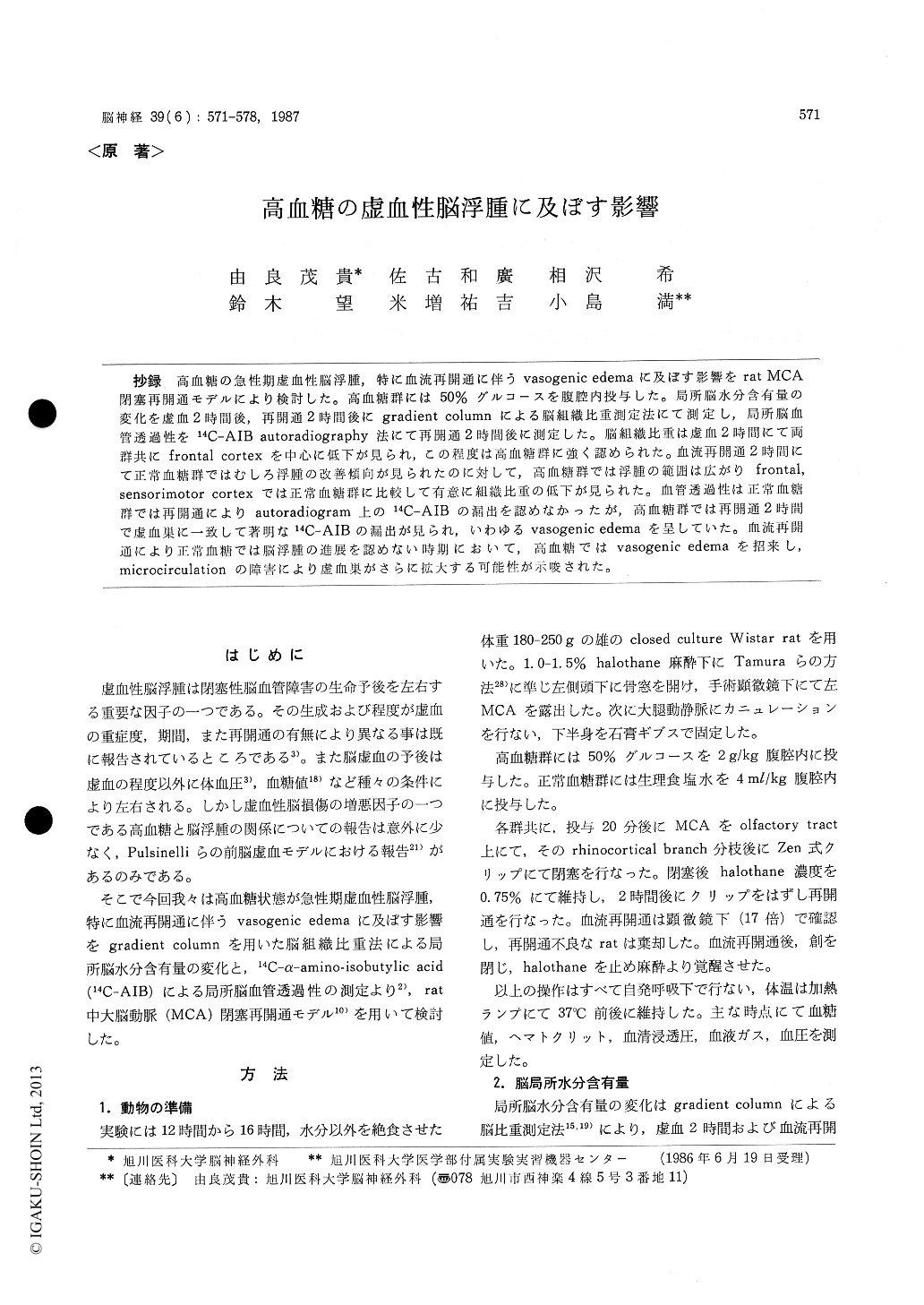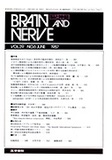Japanese
English
- 有料閲覧
- Abstract 文献概要
- 1ページ目 Look Inside
抄録 高血糖の急性期虚血性脳浮腫,特に血流再開通に伴うvasogenic edemaに及ぼす影響をrat MCA閉塞再開通モデルにより検討した。高血糖群には50%グルコースを腹腔内投与した。局所脳水分含有量の変化を虚血2時間後,再開通2時間後にgradient columnによる脳組織比重測定法にて測定し,局所脳血管透過性を14C-AIB autoradiography法にて再開通2時間後に測定した。脳組織比重は虚血2時間にて両群共にfrontal cortexを中心に低下が見られ,この程度は高血糖群に強く認められた。血流再開通2時間にて正常血糖群ではむしろ浮腫の改善傾向が見られたのに対して,高血糖群では浮腫の範囲は広がりfrontal,sensorimotor cortexでは正常血糖群に比較して有意に組織比重の低下が見られた。血管透過性は正常血糖群では再開通によりautoradiogram上の14C-AIBの漏出を認めなかったが,高血糖群では再開通2時間で虚血巣に一致して著明な14C-AIBの漏出が見られ,いわゆるvasogenic edemaを呈していた。血流再開通により正常血糖では脳浮腫の進展を認めない時期において,高血糖ではvasogenic edemaを招来し,microcirculationの障害により虚血巣がさらに拡大する可能性が示唆された。
The effects of hyperglycemia on ischemic brain edema in rats were studied by measuring the local changes in water content of brain and cerebro-vascular permeability using a transient middle cerebral artery (MCA) occlusion model.
Rats, fasted except for water for 12-16 hours, were used. They were anesthetized with halothane and the stem of the left MCA was occluded for 2 hours by a microclip. Reperfusion was performed by removal of the clip. The rats were allowed to awake from anesthesia after removal of the clip. Hyperglycemia was induced by intraperitoneal injection of 50% glucose and same volume of physiological saline was injected intraperitoneally 20 minutes before MCA occlusion in control rats. Cerebrovascular permeability was measured by quantitative autoradiography using 14C-α-amino-isobutyric acid (14C-AIB) 2 hours after reperfusion. The specific gravity of cerebral tissue, determined by the gradient column with bromobenzene and kerosen, was used to study local changes in brain water content 2 hours after MCA occlusion and 2 hours after reperfusion.
In hyperglycemic rats, plasma glucose concent-ration rose to over 500 mg/dl at the peak and then declined. A hyperglycemic state around 300 mg/dl was maintained during the experiments. Elevation of hematocrit and plasma osmolarity were observed in hyperglycemic rats.
At 2 hours after MCA occlusion, specific gravity of the brain was decreased in the left MCA ter-ritory, especially in the frontal cortex, in both groups. The decrease in the frontal cortex in hyperglycemic rats was statistically significant compared with that in the control rats.
At 2 hours after restoration of blood flow fol-lowing 2 hours MCA occlusion, in hyperglycemic rats, the decreases of specific gravities became significant in the entire territory of the left MCA. 14C-AIB autoradiograms disclosed prominent and extensive leakage of the radioactive tracer within the previously ischemic area. This may be inter-preted as that so called "vasogenic edema" was induced by restoration of blood flow in hyper-glycemic rats. On the other hand, in normogly-cemic rats, no demonstrable leakage of the tracer was observed, and specific gravity of the brain revealed a trend to edema resolution.
Ischemic brain edema in early ischemic phase(probably "cytotoxic type") is more prominent in hyperglycemic rats than in normoglycemic rats. Early reperfusion in hyperglycemic rats induces a vasogenic edema, however, it is not observed in normoglycemic rats. Our data suggest the possibi-lity, in hyperglycemia, that reperfusion in acuteischemic phase rather extends postischemic hypo-perfusion area because of the increase of cerebro-vascular resistance and the reduction of perfusion pressure associated with edema development.

Copyright © 1987, Igaku-Shoin Ltd. All rights reserved.


